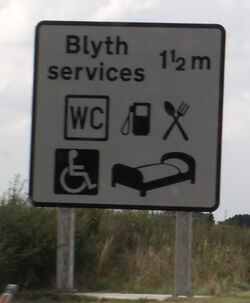Traffic Signs Agreement

The Strategic Highway Traffic Signs Agreement (SHTSA) was created by National Highways in October 2023, as a legal agreement between the highway authority and the operator of a service area, truckstop, rest area or EV hub. They allow official road signs to be provided on the major road network promoting the facility, in exchange for it meeting the minimum requirements outlined at each link. The operator must also agree to fund the agreed amount of road signs, the installation of which can be complex and expensive.
The agreement will usually confirm the name of the service area, and the location of all the new and amended road signs, as well as outlining who now owns each sign. Although a SHTSA is signed with an operator, it applies to the site, and remains valid if that site is sold to another operator. The records also aren't updated when signs move, but the operator is required to keep their signs updated if the information changes.
Between 1993 and 2023, a different agreement called a Traffic Signs Agreement (TSA) was used. Almost all sites are still documented under a TSA rather than a SHTSA, but historic record keeping was non-existent, so there are a lot of service areas which are just assumed to have one.
While the SHTSA is useful, the TSA was actually created to tackle a legal issue: motorways are not allowed to provide access to private businesses, but an exception was made for places with a TSA. Without that exception, motorway service areas couldn't exist.
TSAs were created for use on English trunk roads. It's not clear whether a similar system is used by other highway authorities; it's unlikely that they would want the hassle. During one case in 2022, National Highways said that the content of road signs had to be agreed "in principle" with the local highway authority. In Ireland, a very similar policy exists but it is simply a "Letter of Agreement" between Transport Infrastructure Ireland and the service area operator.
Breaches
According to the regulations, if a service area fails to provide what it is expected to, then the SHTSA/TSA becomes invalid and the road signs must be taken down. If this is a motorway where the exit only serves a service area, then that exit is required to be closed too.
In practice, an extreme response like that is never taken. A blind eye is usually turned to temporary issues. One restaurant operator told us about a fight he was having to get Highways England (as-was) to take the signs down, because he wasn't providing the advertised facilities and didn't want to mislead people. Taking down road signs can involve an expensive road closure, so nobody will offer to do it when they don't need to.
In theory, "Services" signs shouldn't be erected without a Traffic Signs Agreement, but exceptions are frequently made. Usually, this is because they use the "a generic description of a facility" clause, but there will also be cases where a well-meaning highway authorities put extra signs up to be helpful. There will probably be some cases of very old signs that keep being updated with nobody checking whether the place actually qualifies.
Documentation
As suggested above, government departments (especially ones which have been renamed many times) are not known for good record keeping. England's national highway authority has consulted this website for a list of signposted service areas at least three times, suggesting they aren't even keeping hold of a list they asked for, let alone find agreements which ought to have been signed decades ago. Motorway Services Online would like to list every service area with a valid SHTSA/TSA, but with the system being so muddled, we can only list the places which look like they would to have one.
Increasingly, some developers are choosing to build service areas next to junctions and not apply for a SHTSA, on the basis that online listings and word-of-mouth offer all the same benefits, without the expense or responsibility of SHTSAs. On motorways, this practice has been stopped, if the 2022 regulations are enforced; all roadside facilities at motorway junctions must qualify for and receive a SHTSA, if they are to receive planning permission.